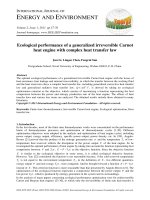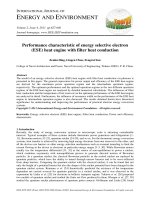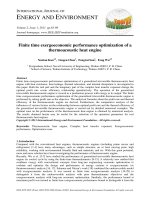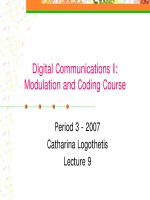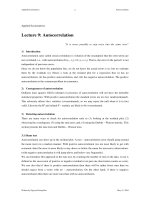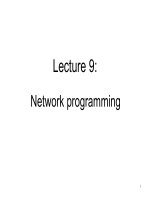Lecture 9 heat engine
Bạn đang xem bản rút gọn của tài liệu. Xem và tải ngay bản đầy đủ của tài liệu tại đây (224.9 KB, 11 trang )
CHAPTER 22 HEAT ENGINES,
ENTROPY, AND THE SECOND LAW
OF THERMODYNAMICS
Lecturer: Tran Thi Ngoc Dung
heat engine
• A heat engine is a device that takes
in energy by heat and, operating in a
cyclic process, expels a fraction of
that energy by means of work.
• A heat engine carries some working
substance through a cyclic process
during which
• (1) the working substance absorbs
energy by heat from a high-temperature
energy reservoir,
• (2) work is done by the engine,
• (3) energy is expelled by heat to a lowertemperature reservoir.
The Efficiency of an Engine
The Efficiency of an Engine e
Work_ done _ by _ the _ engine
W'
Heat _ received_ from_ hot _ reservoir Q h
Engine operates in a cycle process, the change in internal energy is 0:
U Qh Qc W 0
Work done by the
engine:
W ' W Q h Qc
'
Q h Qc
W ' Q h Q 'c
Q 'c
e
1
Qh
Qh
Qh
Example
• An engine transfers 2.00 x 103 J of energy from a hot
reservoir during a cycle and transfers 1.50 x 103 J as
exhaust to a cold reservoir.
(A)Find the efficiency of the engine.
(B)How much work does this engine do in one cycle?
Q 'c
1.5 103
e 1
1
25%
3
Qh
2 10
W'
'
Q h Qc
(2 10 ) (1.5 10 ) 0.5 10 J
3
3
3
The Carnot Engine
• The engine operates in a cyclic process consisting of 2
isothermal processes and 2 adiabatic processes.
AB : isothermal : Q AB nRTh ln(
VB
)0
VA
BC : adiabatic : Q BC 0
CD : isothermal : Q CD nRTc ln(
DA : adiabatic : Q DA 0
Q h Q AB nRTh ln(
VB
)
VA
Q'c Q CD nRTc ln(
VC
)
VD
VC
)
Q'c
VD
e 1
1
V
Qh
Th ln( B )
VA
Tc ln(
VD
)0
VC
The Carnot Engine (cont.)
VC
)
Q'c
VD
e 1
1
V
Qh
Th ln( B )
VA
Tc ln(
BC : adiabatic : TV 1 const
Th VB 1 Tc VC 1
DA : adiabatic : TV 1 const
Th VA 1 Tc VD 1
VB VC
VA VD
Tc
e 1
Th
Carnot Cycle
In process D -A , (Active
Fig. 22.9d), the base of the
cylinder is replaced by a
nonconducting wall and the
gas
is
compressed
adiabatically.
The temperature of the gas
increases to Th, and the
work done by the piston
on the gas is WDA.
In process C S D (Active Fig. 22.9c), the
gas is placed in thermal contact
with an energy reservoir at temperature Tc
and is compressed isothermally
at temperature Tc.
During this time, the gas expels energy
|Qc| to the reservoir and the work done by
the piston on the gas is WCD.
Process A B is an isothermal
expansion at temperature Th.
The gas is placed in thermal
contact with an energy reservoir at
temperature Th. During the
expansion, the gas absorbs
energy |Qh| from the reservoir
through the base of the cylinder
and does work WAB in raising the
piston.
In process B C (Active Fig. 22.9b), the
base of the cylinder is replaced by a
thermally nonconducting wall and the gas
expands adiabatically; that is, no energy
enters or leaves the system by heat. During
the expansion, the temperature of the gas
decreases from Th to Tc and the gas does
work WBC
in raising the piston.
22.2 Heat Pumps and Refrigerators
In a refrigerator or a heat
pump, the engine takes in
energy |Qc| from a cold
reservoir and expels energy
|Qh| to a hot reservoir (Active
Fig. 22.4), which can be
accomplished only if work is
done on the engine.
Refrigerator
The effectiveness of a heat pump /refrigerators is described in terms of a
number called the coefficient of performance
COP(cooling mod e)
heat _ received _ from _ cold _ reservoir Q c
Work _ done _ on _ the _ refrigerator
W
U Q h Q c W 0
W Q h Q c Q 'h Q c
Qc
COP(cooling mod e)
Q 'h Q c
Tc
Carnot _ cycle : COP(cooling mod e)
Th Tc
Heat Pump
COP(heating mod e)
heat _ delivered _ to _ hot _ reservoir Q'h
Work _ done _ on _ the _ refrigerator W
U Q h Q c W 0
W Q h Q c Q 'h Q c
Q 'h
COP(heating mod e)
Q 'h Q c
Carnot _ cycle : COP(heating mod e)
Th
Th Tc
Example 22.5 Efficiency of the Otto Cycle
Find the thermal efficiency of an engine operating in an idealized Otto cycle. Treat
the working substance as an ideal gas.
AB : adiabatic : Q AB 0
BC : isovolumetric : Q BC nC V (TC TB ) 0
CD : adiabatic : QCD 0
DA : isovolumetric : Q DA nC V (TA TD ) 0
Q h Q BC nC V (TC TB )
Q'c Q DA nC V (TD TA )
Q'
T TA
e 1 c 1 D
Qh
TC TB
AB : adiabatic : TV 1 const
TA V1 1 TBV2 1
CD : adiabatic : TV 1 const
TD V1 1 TC V2 1
V1 1 TB TC TC TB
1
TA TD TD TA
V2
V2
Q'c
e 1
1
Qh
V1
1
